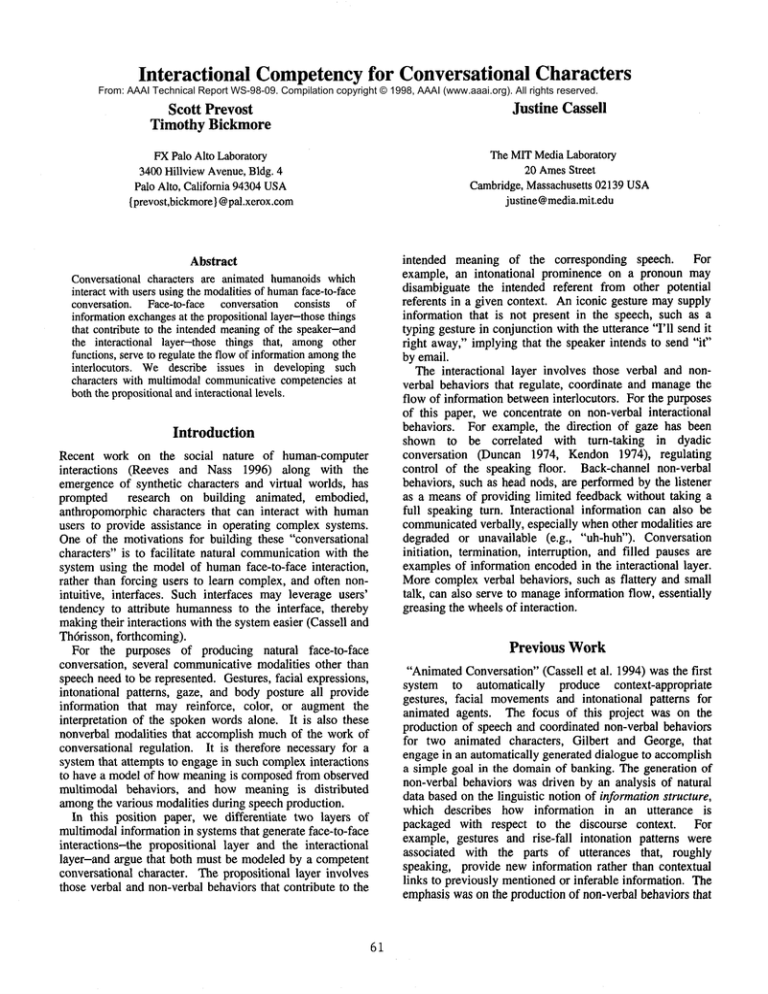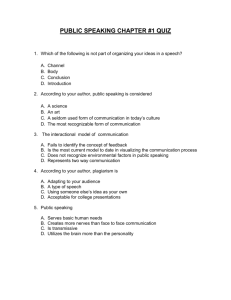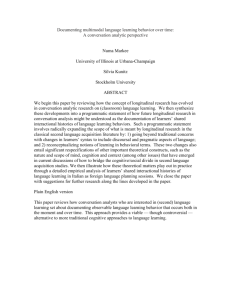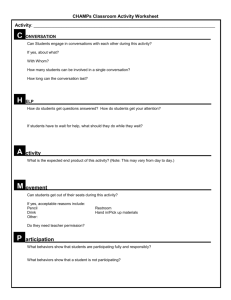
Interactional Competencyfor Conversational Characters
From: AAAI Technical Report WS-98-09. Compilation copyright © 1998, AAAI (www.aaai.org). All rights reserved.
Justine Casseil
Scott Prevost
Timothy Bickmore
FXPalo Alto Laboratory
3400Hillview Avenue,Bldg. 4
Palo Alto, California 94304USA
{ prevost,bickmore
} @pal.xerox.corn
The MITMediaLaboratory
20 AmesStreet
Cambridge,Massachusetts 02139 USA
justine@media.mit.edu
Abstract
Conversational characters are animated humanoidswhich
interact with users using the modalitiesof human
face-to-face
conversation. Face-to-face conversation consists of
informationexchangesat the propositionallayer--thosethings
that contribute to the intended meaningof the speaker-and
the interactional layer--those things that, amongother
functions, serve to regulate the flowof informationamong
the
interlocutors. Wedescribe issues in developing such
characters with multimodalcommunicativecompetenciesat
boththe propositionalandinteractionallevels.
Introduction
Recent work on the social nature of human-computer
interactions
(Reeves and Nass 1996) along with the
emergence of synthetic characters and virtual worlds, has
prompted research on building animated, embodied,
anthropomorphic characters that can interact with human
users to provide assistance in operating complex systems.
One of the motivations for building these "conversational
characters" is to facilitate natural communicationwith the
system using the model of humanface-to-face interaction,
rather than forcing users to learn complex, and often nonintuitive, interfaces. Such interfaces mayleverage users’
tendency to attribute humannessto the interface, thereby
makingtheir interactions with the systemeasier (Cassell and
Th6risson, forthcoming).
For the purposes of producing natural face-to-face
conversation, several communicativemodalities other than
speech need to be represented. Gestures, facial expressions,
intonational patterns, gaze, and body posture all provide
information that may reinforce, color, or augment the
interpretation of the spoken words alone. It is also these
nonverbal modalities that accomplish muchof the work of
conversational regulation. It is therefore necessary for a
system that attempts to engage in such complexinteractions
to have a model of howmeaning is composedfrom observed
multimodal behaviors, and how meaning is distributed
amongthe various modalities during speech production.
In this position paper, we differentiate two layers of
multimodalinformation in systems that generate face-to-face
interactions-the propositional layer and the interactional
layer-and argue that both must be modeled by a competent
conversational character. The propositional layer involves
those verbal and non-verbal behaviors that contribute to the
61
intended meaning of the corresponding speech. For
example, an intonational prominence on a pronoun may
disambiguate the intended referent from other potential
referents in a given context. An iconic gesture maysupply
information that is not present in the speech, such as a
typing gesture in conjunction with the utterance ’TII send it
right away," implying that the speaker intends to send "it"
by email.
The interactional layer involves those verbal and nonverbal behaviors that regulate, coordinate and managethe
flow of information betweeninterlocutors. For the purposes
of this paper, we concentrate on non-verbal interactional
behaviors. For example, the direction of gaze has been
shown to be correlated
with turn-taking
in dyadic
conversation (Duncan 1974, Kendon 1974), regulating
control of the speaking floor. Back-channel non-verbal
behaviors, such as head nods, are performedby the listener
as a means of providing limited feedback without taking a
full speaking turn. Interactional information can also be
communicatedverbally, especially whenother modalities are
degraded or unavailable (e.g., "uh-huh"). Conversation
initiation, termination, interruption, and filled pauses are
examplesof information encoded in the interactional layer.
Morecomplex verbal behaviors, such as flattery and small
talk, can also serve to manageinformation flow, essentially
greasing the wheelsof interaction.
Previous
Work
"AnimatedConversation" (Cassell et al. 1994) was the first
system to automatically produce context-appropriate
gestures, facial movementsand intonational patterns for
animated agents. The focus of this project was on the
production of speech and coordinated non-verbal behaviors
for two animated characters, Gilbert and George, that
engage in an automatically generated dialogue to accomplish
a simple goal in the domainof banking. The generation of
non-verbal behaviors was driven by an analysis of natural
data based on the linguistic notion of information structure,
which describes how information in an utterance is
packaged with respect to the discourse context. For
example, gestures and rise-fall intonation patterns were
associated with the parts of utterances that, roughly
speaking, provide new information rather than contextual
links to previously mentionedor inferable information. The
emphasis was on the production of non-verbal behaviors that
emphasize and reinforce the content of the speech--the
propositional layer. Regulatory signals, such as turn-taking
cues, were derived automatically from the strict turn-taking
produced by the dialogue planner rather than from
observable gaze behaviors or back-channels.
The "Ymir" system, (Th6risson 1996) takes a much
different approach, focusing on integrating multimodalinput
from a humanuser, including gesture, gaze, speech, and
intonation, and producing multimodal output in an animated
character called "Gandalf." The system allows a user to
interact with Gandalf to manipulate a graphical modelof the
solar system and to pose simple questions about the planets.
Unlike Gilbert and George in the Animated Conversation
project, Gandalf’s understanding and production of nonverbal behaviors occurs mostly in the interactional layer.
Although Gandalf has very limited knowledge and
extremelyrestricted linguistic abilities, his ability to perceive
and generate turn-taking cues and backchannel behaviors
(e.g. head nods, direction of gaze) creates a smoothness
interaction that surpasses anthropomorphic interfaces
without these interactional characteristics (Cassell and
Th6risson, forthcoming).
Other character-based interfaces, such as Microsoft
Persona (Ball et al. 1997) and PPP Persona (Andre, Muller,
and Rist 1996), enforce rigid notions of alternating turns,
and thus do not utilize informationin the interactional layer.
Speech-only mixed-initiative dialogue systems, such as
TRAINS
(Allen, et al. 1996), fail to process any of the nonverbal behaviors that convey interactional information in
face-to-face conversation.
Research Issues
While Gilbert and George, and Gandalf represent significant
advances in autonomous, embodied, animated agents,
neither system is complete. Gilbert and George cannot
interact with real people in real time, and fail to produce
convincing turn-taking
and backchannel behaviors.
Gandalf, on the other hand, fails to model planning,
language and propositional non-verbal behaviors at a level
necessary for accomplishing non-trivial tasks. Webelieve
that, in order to overcome these deficiencies, the next
generation of animated, conversational characters must
integrate the propositional and interactional layers of
communication,and account for their interactions.
Consider the turn-taking
problem. In "Animated
Conversation," turns are allocated by a planner that has
access to both agents’ goals and intentions. In the real
world, turns are negotiated through interactional non-verbal
cues, rather than strictly imposedby the structure of the
underlying task. In Gandalf, turns are negotiated by the
agent and the humanuser in a natural way. Since Gandalf
does no dialogue planning, however,each turn is artificially
restricted to a single utterance. To competentlyhandle turntaking in non-trivial, mixed-initiative, multimodaldialogue,
a system must interleave and process the propositional and
interactional information in a principled way.
There are several significant research issues which must
be addressed in building conversational characters with this
capability. Theseare best described in terms of the impact of
62
interactional
competency on the components of a more
traditional natural languagedialogue system.
Understanding
In a multimodal conversation system, the understanding
component must not only integrate
information from
different modalities into a coherent propositional
representation of what the user is communicating,but--in
order to knowwhat function that information fills in the
ongoing conversation--it must also derive the interactional
information from the perceptual inputs. Moreover, it must
determine when the user has communicatedenough to begin
analysis and be able to re-analyze input in case it
misinterprets the user’s turn-taking cues.
Discourse Planning
The discourse planner for conversational characters must be
able to plan turn-taking sequences and easily adapt when
those plans are invalidated by non-verbal cues--for example
whenthe humanrefuses to give over the turn, and continued
nonverbal feedback becomes more appropriate than adding
newcontent to the conversation.
Generation
When the discourse plan calls for the generation of
interactional information, the character must decide which
modality to use, and must take into account interactional
information from the user. For example, signaling an
interruption or termination may be performed verbally or
with a nod of the head depending on whether the user or the
character currently has the turn.
Finally, the issues of real-time performance and
synchronization
are crucial factors for embodied
conversational systems. Characters must respond to a user’s
utterance within a short period of time in order to maintain
the appearance of having conversational competency. Many
interactional responses, such as back-channelfeedback, must
be timed within a fraction of a second to convey the
appropriate message. Since performing natural language
understanding, discourse planning, and text generation in a
principled way is computationally complex, characters may
need to be constructed from a suite of communicationskill
processes whichare operating with different response times.
In fact, if the system’s faster reactions are aptly timed, this
mayprovide more time for the slower, reflective layer to
comeup with the correct content, either in understanding or
generation. That is, a well placed "hmm,let’s see" with slow
thoughtful nods of the head can give users necessary
information about the state of the conversation, while
allowing the system a little more time to come up with a
contentful response.
Conclusion
Effective conversational characters will require competency
in both propositional
and interactionai
layers of
communication, and must address the issue of how these
layers are integrated. Weare currently developing a generic
conversational character architecture which addresses these
issues as a joint project between FXPalo Alto Laboratory
and the MITMedia Laboratory.
References
Allen, L; Miller, B.; Ringger, E.; and Sikorski, T. 1996. A
Robust System for Natural SpokenDialog. In Proceedings of
the 34 t~ Annual Meeting of the Association
for
ComputationalLinguistics, 62-70. Santa Cruz, Calif.
Andre, E.; Muller, J.; and Rist, T. 1996. The PPP Persona:
A Multipurpose Animated Presentation Agent. In the Proc.
of AdvancedVisual Interfaces, ACM
Press.
Ball, G.; Ling, D.; Kurlander, D.; Miller, D.; Pugh, D.;
Skelly, T.; Stankosky, A.; Thiel, D.; Van Dantzich, M. and
Wax, T. 1997. Lifelike computer characters: the persona
project at Microsoft Research. In J. M. Bradshaw (ed.)
Software Agents, Cambridge, MA:MITPress.
Cassell, J.; Pelachaud, C.; Badler, N.; Steedman, M.;
Achorn, B.; Tripp, B.; Douville B.; Prevost, S.; and Stone,
M. 1994. Animated Conversation: Rule-based Generation of
Facial Expression, Gesture & Spoken Intonation for
Multiple Conversational
Agents, In Proceedings of
SigGraph 1994, 413-420.
Cassell, J. and Th6risson, K. Forthcoming. The power of a
nod and a glance: envelope vs. emotional feedback in
animated conversational
agents. Applied Artificial
Intelligence, forthcoming.
Duncan, S. 1974. Some Signals and Rules for Taking
Speaking Turns in Conversations. In Weitz (ed.), Nonverbal
Communication:Oxford University Press.
Kendon, A. 1974. Movement Coordination in Social
Interaction: SomeExamples Described. In Weitz (ed.),
Nonverbal Communication:Oxford University Press.
Reeves, B., and Nass, C. 1996. The Media Equation:
CambridgeUniversity Press.
Thorisson,
K. 1996. Communicative Humanoids: A
Computational Model of Psychosocial Dialogue Skills. PhD
dissertation, MITMedia Laboratory.
63





